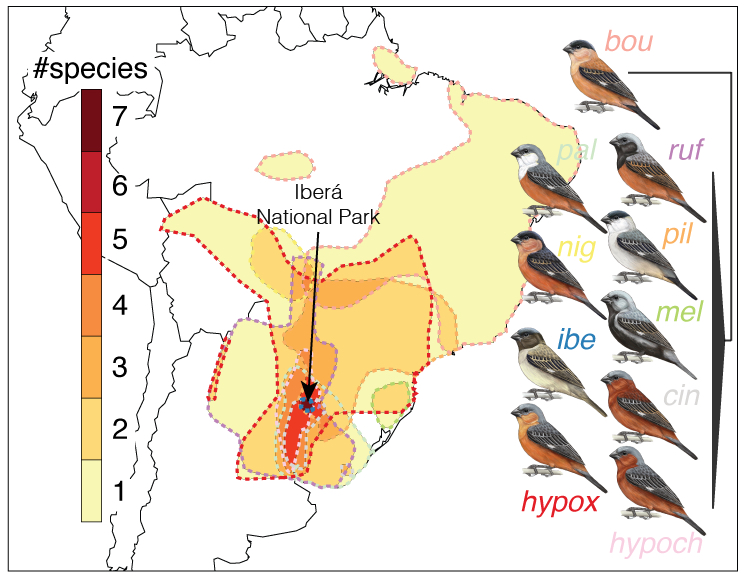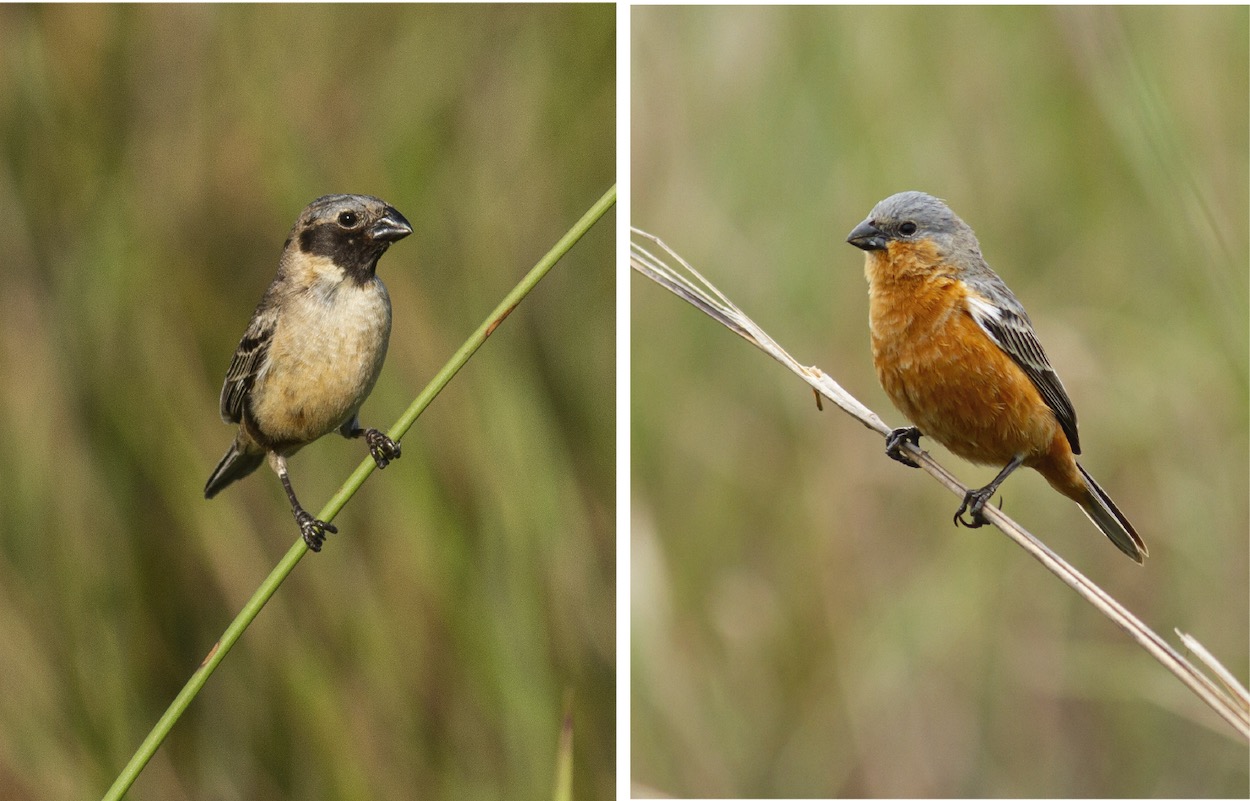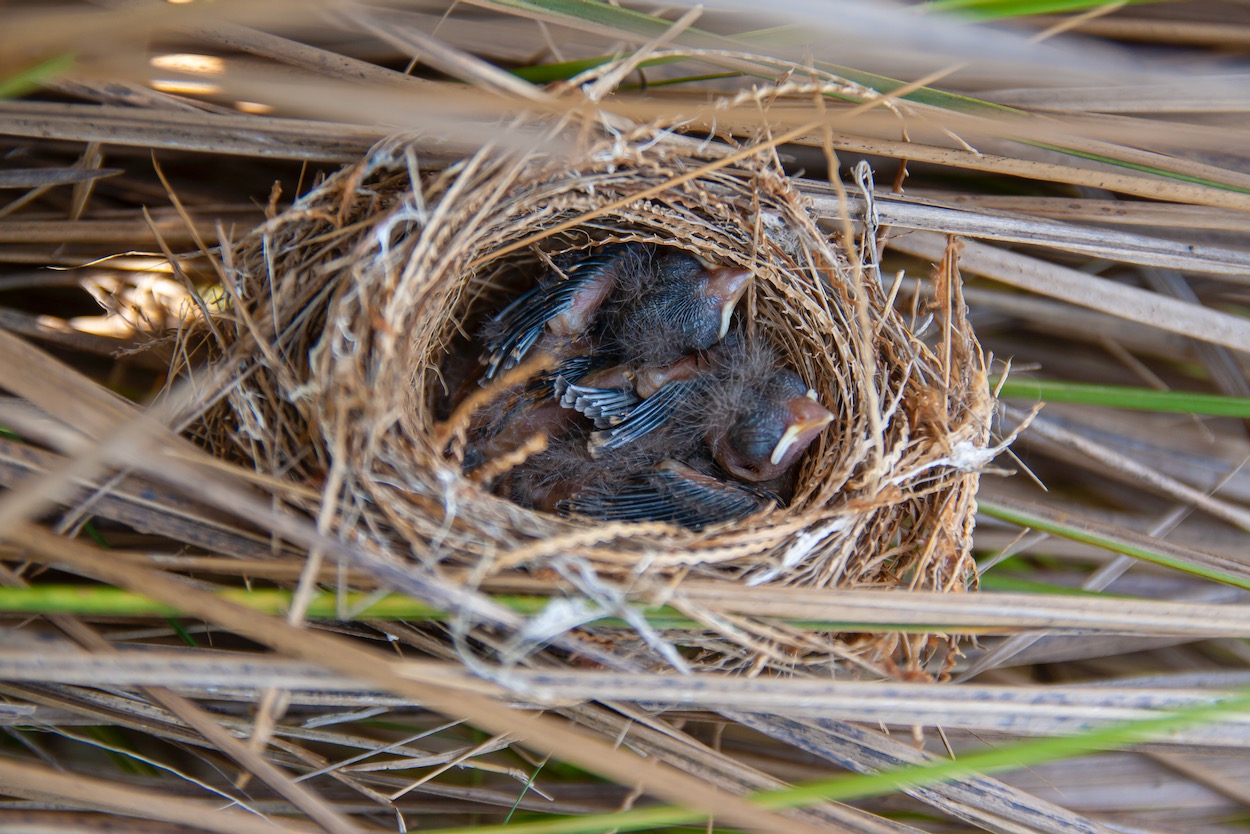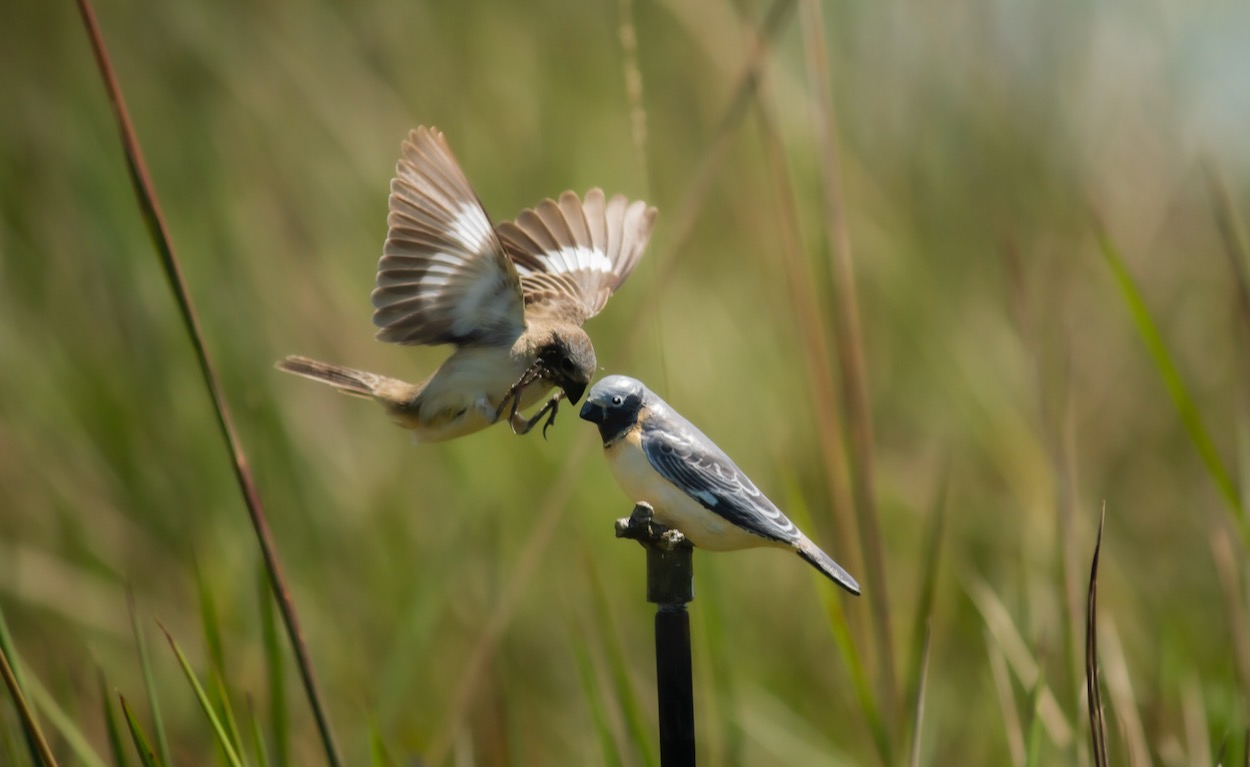Report from a BOU-funded project
LINKED PAPER
Rapid speciation via the evolution of pre-mating isolation in the Iberá Seedeater. Turbek, S.P., Browne, M., Di Giacomo, A.S., Kopuchian, C., Hochachka, W.M., Estalles, C., Lijtmaer, D., Tubaro, P., Silveira, L.F., Lovette, I.J., Safran, R.J., Taylor, S.A., & L. Campagna. 2021 Science. DOI: 10.1126/science.abc0256 VIEW
 Wander through the subtropical grasslands of South America and you are sure to hear the melodious whistles of the southern capuchino seedeaters. Weighing merely 8 grams and easy to overlook, these skillful songsters comprise one of the most recent and rapid avian radiations on the planet (Campagna et al. 2017). Much like Darwin’s finches, which diverged into numerous species that differ in bill shape and size (Grant 1999), capuchinos have diversified within the last million years to form ten species that vary in male plumage coloration and song (Campagna et al. 2012). However these two avian radiations differ in that Darwin’s finches are isolated on separate islands in the Galápagos Archipelago, while capuchino species largely breed in the same place at the same time. Add to that the fact that capuchinos are virtually identical on a genetic level (Campagna et al. 2017), and this group becomes somewhat of an evolutionary enigma.
Wander through the subtropical grasslands of South America and you are sure to hear the melodious whistles of the southern capuchino seedeaters. Weighing merely 8 grams and easy to overlook, these skillful songsters comprise one of the most recent and rapid avian radiations on the planet (Campagna et al. 2017). Much like Darwin’s finches, which diverged into numerous species that differ in bill shape and size (Grant 1999), capuchinos have diversified within the last million years to form ten species that vary in male plumage coloration and song (Campagna et al. 2012). However these two avian radiations differ in that Darwin’s finches are isolated on separate islands in the Galápagos Archipelago, while capuchino species largely breed in the same place at the same time. Add to that the fact that capuchinos are virtually identical on a genetic level (Campagna et al. 2017), and this group becomes somewhat of an evolutionary enigma.
 Figure 1 Map showing the geographic distribution of the ten southern capuchino seedeater species (modified from Turbek et al. 2021). Up to seven capuchinos breed in Iberá National Park in Corrientes, Argentina.
Figure 1 Map showing the geographic distribution of the ten southern capuchino seedeater species (modified from Turbek et al. 2021). Up to seven capuchinos breed in Iberá National Park in Corrientes, Argentina.
In 2016, researchers described a newly identified capuchino species in northern Argentina: the Iberá Seedeater (Sporophila iberaensis) (Di Giacomo & Kopuchian 2016). Named after Iberá National Park, its only known breeding location, this species co-occurs side by side with the Tawny-bellied Seedeater (Sporophila hypoxantha) throughout its extremely restricted breeding range.
 Figure 2 Male Iberá Seedeater (left) and Tawny-bellied Seedeater (right), which hold neighboring breeding territories in Iberá National Park. Photos: Sheela Turbek
Figure 2 Male Iberá Seedeater (left) and Tawny-bellied Seedeater (right), which hold neighboring breeding territories in Iberá National Park. Photos: Sheela Turbek
In a study published last week in Science (Turbek et al. 2021) and funded in part by a BOU Small Research Grant, we took advantage of the Iberá Seedeater’s recent identification to investigate the factors that have allowed capuchino seedeaters to rapidly diversify. Over the course of several breeding seasons, we located nests and collected blood samples from adults and nestlings of the Iberá Seedeater and Tawny-bellied Seedeater in Iberá National Park. By sequencing the DNA of the two species, we discovered that these capuchinos are only distinguished by three tiny genomic regions containing just 12 genes. Interestingly, three of these genes are known to control plumage coloration and likely encode the diverse plumage patterns observed in this group.
You may ask yourself, ‘should birds that are so genetically similar even be classified as separate species?’ Females of the Iberá Seedeater and Tawny-bellied Seedeater are indistinguishable to the human eye, so to address this question, we again relied on DNA sequencing data to examine whether the two capuchinos interbreed in the wild. We were surprised to find that, even though the two species hold neighboring territories, feed on the same grasses, and breed at the same time, they only paired with members of their own species. These results were additionally supported when we investigated patterns of mating outside of the social pair bond. While an astounding 52% of capuchino offspring were sired by males other than their social father, we did not detect any hybridization between the species through extra-pair mating.
 Figure 3 Nestlings of the Iberá Seedeater. Photo: Sheela Turbek
Figure 3 Nestlings of the Iberá Seedeater. Photo: Sheela Turbek
To further examine the importance of plumage coloration and song in behavioral interactions between capuchinos, we presented territorial males of the Iberá Seedeater and Tawny-bellied Seedeater with different combinations of painted mounts and song recordings to test the males’ responses to their own song and plumage vs. that of the other capuchino species. Both capuchinos responded most aggressively to the song and plumage of their own species, indicating that the two traits are jointly used to identify conspecifics.
 Figure 4 A male Iberá Seedeater attacks a mount used in the behavioral study. The mount was painted to mimic the male’s plumage patterning and played the species-specific song of the Iberá Seedeater to examine the role of song and plumage in territorial interactions. Photo: Sheela Turbek
Figure 4 A male Iberá Seedeater attacks a mount used in the behavioral study. The mount was painted to mimic the male’s plumage patterning and played the species-specific song of the Iberá Seedeater to examine the role of song and plumage in territorial interactions. Photo: Sheela Turbek
Thus, it appears that the Iberá Seedeater and Tawny-bellied Seedeater distinguish one another in territorial interactions and avoid interbreeding by keying into differences in plumage patterning and song. However, how did the song and coloration differences between capuchino species arise in the first place? To gain insight into the origin of the Iberá Seedeater, we compared its DNA to that of the nine other southern capuchino species in the radiation. While the Iberá Seedeater possesses its own unique combination of genetic variants controlling plumage coloration, we found that it shares variants with other capuchino species in each of the divergent genomic regions.
Cases of rapid speciation often puzzle evolutionary biologists because it is difficult to imagine how novel mutations that limit interbreeding between closely related organisms can simultaneously evolve in multiple lineages over such a short evolutionary timescale (Marques et al. 2019). Our results indicate that the Iberá Seedeater likely formed as a result of past hybridization between capuchino lineages and the subsequent reshuffling of existing genetic variation into novel combinations encoding differences in plumage patterning and song, rather than through the evolution of new mutations. These findings thus contribute to our understanding of this long-standing evolutionary conundrum.
While many questions remain regarding the evolution of the enigmatic capuchino seedeaters, this investigation sheds light on the conditions under which birds may rapidly diversify. As a growing number of studies apply emerging genomic sequencing technology to research a wide range of avian species, we may find that this mechanism of speciation, involving the reshuffling of existing genetic variation into novel combinations, may be more common than previously thought.
Funding
Sheela Turbek (PhD candidate, University of Colorado, US) was awarded a small ornithological grant of £2,000 in 2019 for a project entitled ‘Explaining mismatches between phenotypic and genetic divergence in a rapid radiation of finch-like birds’.
References
Campagna, L., Benites, P., Lougheed, S.C., Lijtmaer, D.A., Di Giacomo, A.S., Eaton, M.D. & Tubaro, P.L. 2012. Rapid phenotypic evolution during incipient speciation in a continental avian radiation. Proceedings of the Royal Society of London. Series B. Biological Sciences 279: 1847–1856. VIEW
Campagna, L., Repenning, M., Silveira, L.F., Fontana, C.S., Tubaro, P.L. & Lovette, I.J. 2017. Repeated divergent selection on pigmentation genes in a rapid finch radiation. Science Advances 3: e1602404. VIEW
Di Giacomo, A.S. & Kopuchian, C. 2016. Una nueva especie de capuchino (Sporophila:Thraupidae) de los Esteros del Iberá, Corrientes, Argentina. Nuestras Aves 61 :3–5.
Grant, P. 1999. Ecology and evolution of Darwin’s finches. Princeton Univ. Press: Princeton, NJ.
Marques, D.A., Meier, J.I. & Seehausen, O. 2019. A combinatorial view on speciation and adaptive radiation. Trends in Ecology & Evolution 34: 531–544. VIEW
Image credit
Top right: Credit: Sheela Turbek




